|
ECE
171: Introduction to Digital Circuits |
Fall 1999 |
Rev: 11.8.99 |
Lecture Notes 11
Last Time
- Boolean Algebra - 4 More Rules
- Factoring
- Karnaugh Maps
- Definitions
- Many Examples
- 5 & 6 Variables
This Time
- Project Tips
- Karnaugh Maps
- More 5 & 6 Variable Examples
- Don't Cares
- Minimal Products
Project Changes
I made a number of minor changes
to Project 1. Click here to download
the latest version. Be sure to print this version out and follow
it, not the older versions. You can tell if you have the latest
version because it will say Rev. 11.3.99 in the upper righthand
corner. The changes made are listed below.
- I changed the letter for one
of the outputs from E to I. However, you may still use the letter
E for this output if you prefer it.
- A hand-drawn logic diagram must
be included in your lab book.
- The schematic (logic diagram)
printed out using the Mentor Graphics tools should be in your
final report, not the lab book.
- You must show the work that
you do to reduce the number of IC's in your lab book.
- I specified some of the IC's
that you have available to build your circuit.
- The maximum number of IC's that
you may use has been increased from 7 to 8.
Project Tips
- You may use the following IC's
in your design:
- 14 Pin Inverters (6 gates per
IC)
- 14 Pin 8-In NAND's (1 gate per
IC)
- 14 Pin 4-In NAND's (2 gates
per IC)
- 14 Pin 3-In NAND's (3 gates
per IC)
- 20 Pin 2-In NAND's (6 gates
per IC)
- Take advantage of the relationships
among the outputs. For example, if you build a circuit to implement
L and I can you easily obtain N using L and I as inputs? Think
about this carefully.
- Consider if building the complement
of some of the outputs is much easier to build than the original
outputs. For example, if L' is easier to implement than L, it
only takes one inverter to convert L' to L.
- Use the don't cares judiciously.
While they may simplify your expressions for L and N, they may
prevent you from using those outputs to generate I.
- Try finding common factors that
can be shared among the outputs.
Example:
N = ABC + AC'D + B'DF' + CEF'
L = BCE + B'DE + C'DF + AD'F
These can be factored as:
N = A(BC + C'D) + F'(B'D + CE)
L = E(BC + B'D) + F(C'D + AD')
Note that you only need to build logic that implments the common
factors (BC, C'D, and B'D) once for both outputs.
- You may use up to 8 IC's, but
there are many solutions that use 7 IC's and it can be done in
6 IC's.
5-Variable Karnaugh Maps
In the following examples the
distinguished 1-cells are marked in the upper left corner of the
cell with an asterisk (*). The essential prime implicants are
circled in blue, the prime implicants are circled in
black, and the non-essential prime implicants included
in the minimal sum are shown in red.
Example 1
- Prime Implicants: 3
- Distinguished 1-Cells: 12
- Essential Prime Implicants:
3
- Minimal Sums: 1
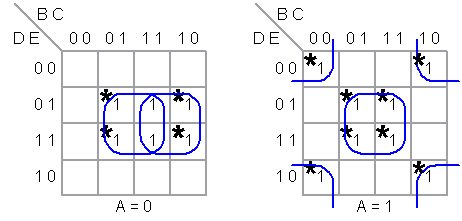
Y = CE
+ A'BE + AC'E'
Example 2
- Prime Implicants: 5
- Distinguished 1-Cells: 9
- Essential Prime Implicants:
5
- Minimal Sums: 1
-
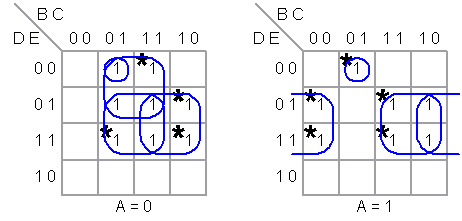
Y = A'CD'
+ A'CE + BE + AC'E + B'CD'E'
Example 3
- Prime Implicants: 5
- Distinguished 1-Cells: 10
- Essential Prime Implicants:
3
- Minimal Sums: 2
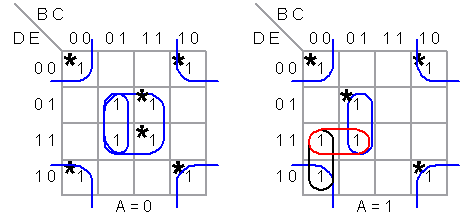
Y = C'E'
+ A'CE + B'CE + AB'C'D
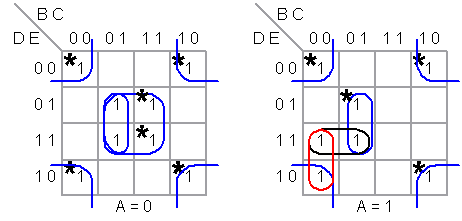
Y = C'E'
+ A'CE + B'CE + AB'DE
Example 4
- Prime Implicants: 10
- Distinguished 1-Cells: 4
- Essential Prime Implicants:
4
- Minimal Sums: 1
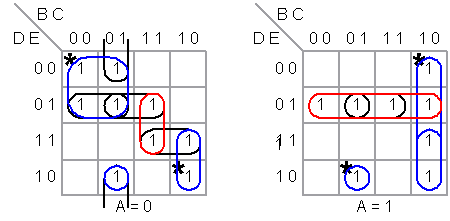
- Y = A'B'D' +
BC'D + B'CDE' + ABC' +
A'BCE + AD'E
-
Example 5
- Prime Implicants: 10
- Distinguished 1-Cells: 4
- Essential Prime Implicants:
4
- Minimal Sums: 1
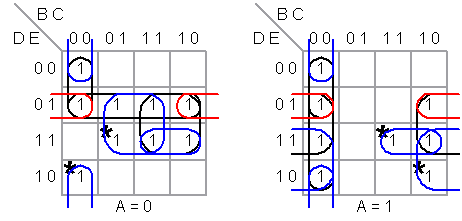
- Y = B'C'E' + A'CE
+ BDE + AC'D +
C'D'E
6-Variable Karnaugh Map Example
- Prime Implicants: 14
- Distinguished 1-Cells: 9
- Essential Prime Implicants:
6
- Minimal Sums: 1
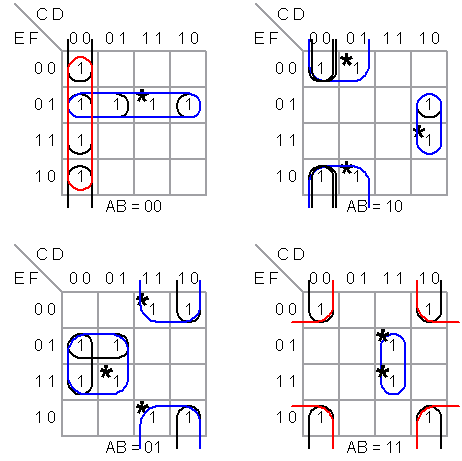
Y = A'B'E'F + AB'C'F' + AB'CD'F + ABCDF + A'BCF' + A'BC'F + A'B'C'D' + ABD'F'
Karnaugh Maps and Don't Cares
Don't cares are represented by
X in Karnaugh maps. They may be used to increase the size
of each group of ones, but you should not circle a group that
contains only X's, no matter how big it is.
Example 1
Let the output Y be 1 if the decimal
equivalent is a prime number between 0 and 9. We don't care what
the output is if the decimal equivalent is greater than 10.
Y =  ABCD(2,3,5,7)
+ d(10-15)
ABCD(2,3,5,7)
+ d(10-15)
- Prime Implicants: 3
- Distinguished 1-Cells: 2
- Essential Prime Implicants:
2
- Minimal Sums: 1
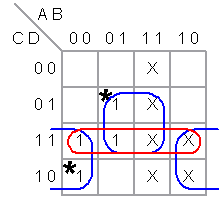
Y = BD
+ CB' + CD
Example 2
Let the output Z be 1 if the decimal
equivalent is not prime number between 0 and 9. We don't care
what the output is if the decimal equivalent is greater than 10.
Z =  ABCD(0,1,4,6,8,9)
+ d(10-15)
ABCD(0,1,4,6,8,9)
+ d(10-15)
- Prime Implicants: 4
- Distinguished 1-Cells: 2
- Essential Prime Implicants:
2
- Minimal Sums: 1
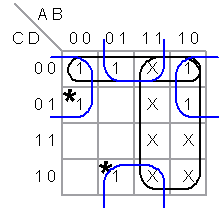
Z = B'C'
+ BD'
Minimal Products
To find the minimal product for
an output variable Y, follow these steps:
- Fill out a Karnaugh map for
Y', the complement of Y.
- Find a minimal sum for Y'.
- Apply DeMorgan's theorem twice.
For example, suppose the minimal
sum for Y' is as follows:
Y' = B'C' + BD'
then the minimal product can be
obtained as follows:
Y' = B'C' + BD'
Y = (B'C' + BD')'
Y = (B'C')' (BD')'
Y = (B + C)(B' + D)








![]() ABCD(2,3,5,7)
+ d(10-15)
ABCD(2,3,5,7)
+ d(10-15)
![]() ABCD(0,1,4,6,8,9)
+ d(10-15)
ABCD(0,1,4,6,8,9)
+ d(10-15)